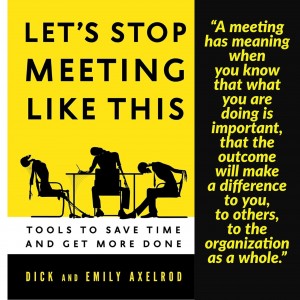Originally published on Switch & Shift
“We need to cut 30 million dollars from operating expenses.” What is your reaction to this purpose statement? Do you want to join the effort or sit on the sidelines?
If your change process lacks purpose, you are lost. You won’t know where you are going and you may not even know how to get there. If your purpose lacks meaning, you end up disengaging the very people you need to engage.
A hospital steering team began to address this 30 million dollar cost reduction problem by clarifying their work’s purpose. While this may seem obvious, the conversations they had were not.
Tips for Creating a Compelling Purpose
The steering team discussed the following questions in order to create a compelling purpose:
- What do you want to create as a result of working together?
- What will be different because this group worked on this project?
- In order to do what?
- To what end?
A doctor said, “I want to have time to treat people humanely.” A patient said, “I want to get treated and go home in a timely manner.” The nurse administrator said, “I need an IT system that works.” The ER nurse said, “I want to treat my patients as humans, not like pieces of meat.” Another doctor said, “I want nurses who can work together.” The nutritionist said, “I want to provide more food options for patients.” The radiologist said, “We need better equipment so I can make better diagnoses.”
The fifth question is the most important question of all…
- Why are you willing to put your own time and effort behind this work?
The steering team members thought about this for a minute. Their response was that they wanted to provide the kind of healthcare that made them want to become healthcare professionals in the first place. They wanted to eliminate the waste in the system that made it difficult for them to do their jobs and harmed patients. They wanted to provide healthcare that made them proud to be healthcare professionals.
They wanted to eliminate the waste in the system that made it difficult for them to do their jobs
You will know you hit pay dirt with this question when the energy and behavior of everyone involved shifts. When people talk authentically about what is important to them, they become more excited and animated. Color comes to their face. When you observe these reactions, you know people are talking about a purpose that has meaning for them.
While reducing cost by 30 million dollars seems like a straightforward process, reducing waste in the system so you can provide the kind of healthcare that makes you proud is a more complex task. A task that has meaning and challenge built in. For this hospital, success required eliminating waste and improving healthcare, and this overall purpose helped the staff meet their individual goals as well.
A compelling purpose provides direction and a way for everyone to see how they connect to the larger whole.
Purpose is your North Star
A compelling purpose provides direction and a way for everyone to see how they connect to the larger whole. When people understand how they fit and what their role is, you create a new sense of engagement.
If you put into practice the five-question dialogue process, you will create for your change process a North Star similar to the one that guided our hospital. A North Star that provides deeper meaning, creates direction, and focuses people on the task at hand.
More about Emily Axelrod
Emily and her husband Dick Axelrod are pioneers in creating employee involvement programs to effect large-scale organization change, and co-founded the Axelrod Group in 1981. Dick and Emily created the Conference Model®, an internationally recognized high-involvement change methodology. Emily is also a guest lecturer in organizational change at Benedict University and she also coached participants in University of Chicago’s Leadership Arts Program. Prior to becoming an executive coach Emily was a family therapist.
Together, Emily and Dick are frequent keynote speakers and co-authors. Their latest book is Let’s Stop Meeting Like This: Tools to Save Time and Get More Done it outlines a flexible and adaptable system used to run truly productive meetings in all kinds of organizations―meetings where people create concrete plans, accomplish tasks, build connections, and move projects forward.


